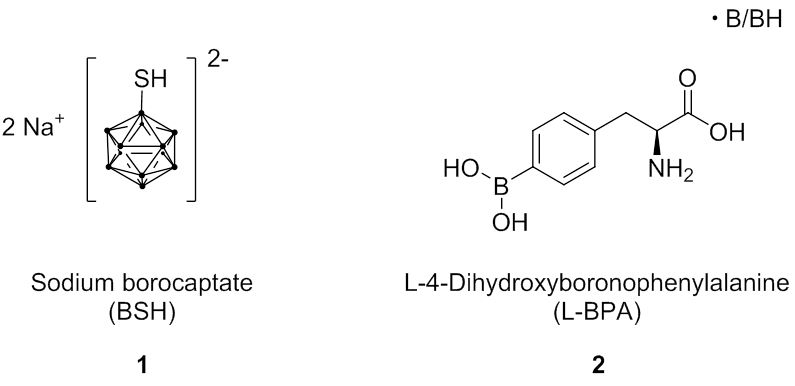The cell-killing effect of boron neutron capture therapy (BNCT) is due to the nuclear reaction of two essentially nontoxic species, boron-10 (10B) and thermal neutrons , whose destructive effect is well observed in boron-loaded tissues. The high accumulation in and selective delivery of 10B to tumor tissue are the most important requirements for an efficient neutron capture therapy for cancer. In order to fatally damage tumor cells with BNCT, three important parameters must be considered in the development of boron carriers: (1) the boron concentrations in the tumor should be in the range of 20–35 μg 10B/g tumor; (2) the tumor/normal tissue ratio should be greater than 3 to 5; and (3) the toxicity should be sufficiently low.
So far, two boron compounds, sodium mercaptoundecahydrododecaborate or sodium borocaptate (Na210B12H11SH; Na210BSH) (1) and L-p-boronophenylalanine (L-10BPA) (2), are used for the treatment of patients with malignant brain tumor s and malignant melanoma .
Recently, BNCT has been applied to various cancers, including head and neck cancer , lung cancer , hepatoma , chest wall cancer, and mesothelioma . In addition, the technology for generation of neutrons employing accelerators has been developing in various countries, and accelerator-based BNCT using L-BPA has already been approved in Japan for treatment of head and neck cancer in March 2020. Since May 2020 the company Stella Pharma is allowed to market Steboronine® (generic name: Borofalan), which is boron-10-enriched (99%) L-BPA as its D-sorbitol complex. This BNCT agent possesses the advantage, in comparison towards the respective fructose-complex, to be storable about 3 years and do not has to be freshly prepared for each use under retention of its GMP grade. Therefore, the development of new and selective boron carriers is one of the most important issues that should be resolved to extend the application of BNCT to various cancers.
In the last decade, boron carrier development has taken two directions: small boron-containing molecules and boron compounds conjugated with biomolecules. Unlike approaches using pharmaceuticals, boron carriers require high tumor selectivity and should be essentially nontoxic. Therefore, the latter approach has become one of the recent trends to accumulate a large amount of 10B in tumor tissues. On the following pages, new and promising candidates for boron carriers developed in the last 20 years are summarized.


